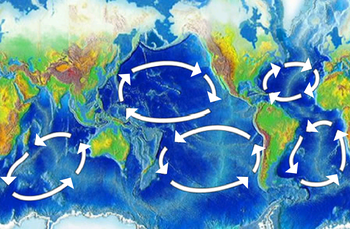Indian Ocean garbage patch


The Indian Ocean garbage patch, discovered in 2010, is a gyre of marine litter suspended in the upper water column of the central Indian Ocean, specifically the Indian Ocean Gyre, one of the five major oceanic gyres.[1][2][3][4][5] The patch does not appear as a continuous debris field. As with other patches in each of the five oceanic gyres, the plastics in it break down to ever smaller particles, and to constituent polymers.[6] As with the other patches, the field constitutes an elevated level of pelagic plastics, chemical sludge, and other debris; primarily particles that are invisible to the naked eye.[7][8][9]
A similar patch of floating plastic debris in the Pacific Ocean, the Great Pacific garbage patch, was predicted in 1985, and discovered in 1997 by Charles J. Moore as he passed through the North Pacific Gyre on his return from the Transpacific Yacht Race. The North Atlantic garbage patch was discovered in 2010.[10][11]
Discovery
The existence of the Great Pacific garbage patch, the first to be discovered, was predicted in a 1988 paper published by the National Oceanic and Atmospheric Administration (NOAA) of the United States. The prediction was based on results obtained by several Alaska-based researchers between 1985 and 1988 that measured neustonic plastic in the North Pacific Ocean.[12]
Research studying trash washed onto beaches in and around the Indian Ocean suggested that there would be plastics found in the water column in the Indian Ocean as well.[2]
In 2010, the 5 Gyres Project set off on the first of its planned series of transoceanic voyages to determine whether the South Atlantic, South Pacific, and Indian Ocean gyres were affected in the same way as the North Pacific and North Atlantic gyres.[1][2][4][5] On the Indian Ocean leg of their trip, they travelled between Perth, Australia, and Port Louis, Mauritius (east of Madagascar); each of the water samples they collected in the 4,800 km (3,000 mi) between contained plastic.[2] They found that the South Atlantic, South Pacific, and Indian Ocean gyres were affected in the same way as the North Pacific and North Atlantic gyres.[1][2][4][5] Anna Cummins, cofounder of 5 Gyres Institute called the pollution they found "a thin plastic soup".[2]
Action for creating awareness
On April 11, 2013, in order to create awareness, artist Maria Cristina Finucci founded The garbage patch state at UNESCO[13] –Paris in front of Director General Irina Bokova, the first of a series of events under the patronage of UNESCO and of Italian Ministry of the Environment.[14]
See also
References
Notes
- ^ a b c First Voyage to South Atantic (sic) Pollution Site SustainableBusiness.com News
- ^ a b c d e f New garbage patch discovered in Indian Ocean, Lori Bongiorno, Green Yahoo, 27 July 2010]
- ^ Opinion: Islands are 'natural nets' for plastic-choked seas Marcus Eriksen for CNN, Petroleum, CNN Tech 24 June 2010
- ^ a b c Our Ocean Backyard: Exploring plastic seas, Dan Haifley, 15 May 2010, Santa Cruz Sentinel
- ^ a b c Life aquatic choked by plastic 14 November 2010, Times Live
- ^ Moore, Charles (November 2003). "Across the Pacific Ocean, plastics, plastics, everywhere". Natural History Magazine.
{{cite journal}}: Cite journal requires|journal=(help) - ^ For a discussion of the current sampling techniques and particle size, see Peter Ryan, Charles Moore et al., Monitoring the abundance of plastic debris in the marine environment. Phil. Trans. R. Soc. B 27 July 2009 vol. 364 no. 1526 1999–2012, doi:10.1098/rstb.2008.0207
- ^ http://www.katu.com/outdoors/featured/112901159.html
- ^ Transoceanic Trash: International and United States Strategies for the Great Pacific Garbage Patch, Susan L. Dautel, 3 Golden Gate U. Envtl. L.J. 181 (2009)
- ^ Lovett, Richard A. (2 March 2010). "Huge Garbage Patch Found in Atlantic Too". National Geographic News. National Geographic Society.
- ^ Victoria Gill (24 February 2010). "Plastic rubbish blights Atlantic Ocean". BBC. Retrieved 16 March 2010.
- ^ Day, Robert H.; Shaw, David G.; Ignell, Steven E. (4). "Quantitative distribution and characteristics of neustonic plastic in the North Pacific Ocean. Final Report to US Department of Commerce, National Marine Fisheries Service, Auke Bay Laboratory. Auke Bay, AK" (PDF) (published 1988). pp. 247–266.
{{cite web}}: Check date values in:|date=and|year=/|date=mismatch (help) - ^ http://www.unesco.org/new/en/venice/about-this-office/single-view/news/the_garbage_patch_territory_turns_into_a_new_state/#.U71u8fl_u9U
- ^ id_articolo=2073
Further reading
- Gregory, M.R.; Ryan, P.G. (1997). "Pelagic plastics and other seaborne persistent synthetic debris: a review of Southern Hemisphere perspectives". In Coe, J.M., Rogers, D.B. (ed.). Marine Debris: Sources, Impacts, Solutions. New York: Springer-Verlag. pp. 49–66.
{{cite book}}: CS1 maint: multiple names: editors list (link) - Masahisa Kubota; Katsumi Takayama; Noriyuki Horii (2000). "Movement and accumulation of floating marine debris simulated by surface currents derived from satellite data" (PDF). School of Marine Science and Technology, Tokai University.
External links
- Pacific Garbage Patch – Smithsonian Ocean Portal
- "Plastic Surf" The Unhealthful Afterlife of Toys and Packaging: Small remnants of toys, bottles and packaging persist in the ocean, harming marine life and possibly even us by Jennifer Ackerman Scientific American August 2010
- photographer Chris Jordan, who recently traveled to a remote part of the Pacific Ocean to document effects of the world’s largest known mass of garbage. in Seed Boustead, Greg (18 February 2010). "§ Appetite for Destruction". Seedmagazine.com. Retrieved 28 July 2010.
- Scripps Environmental Accumulation of Plastic Expedition (SEAPLEX) – Scripps Institution of Oceanography, UC San Diego
- The Project Kaisei Voyage Tracker – Project Kaisei and Ojingolabs
- 5 Gyres – Understanding Plastic Marine Pollution – Algalita, Livable Legacy
- The trash vortex – Greenpeace
- Navigating the Pacific's 'Garbage Patch' – National Public Radio and me
- Marine Research, Education and Restoration – Algalita Marine Research Foundation
- Images & video from the North Pacific gyre – WordPress.com
- Sea of Trash – New York Times Magazine
- Captain Charles Moore on the seas of plastic
- Charles Moore: Sailing the Great Pacific Garbage Patch – TED Conference talk (2009)
